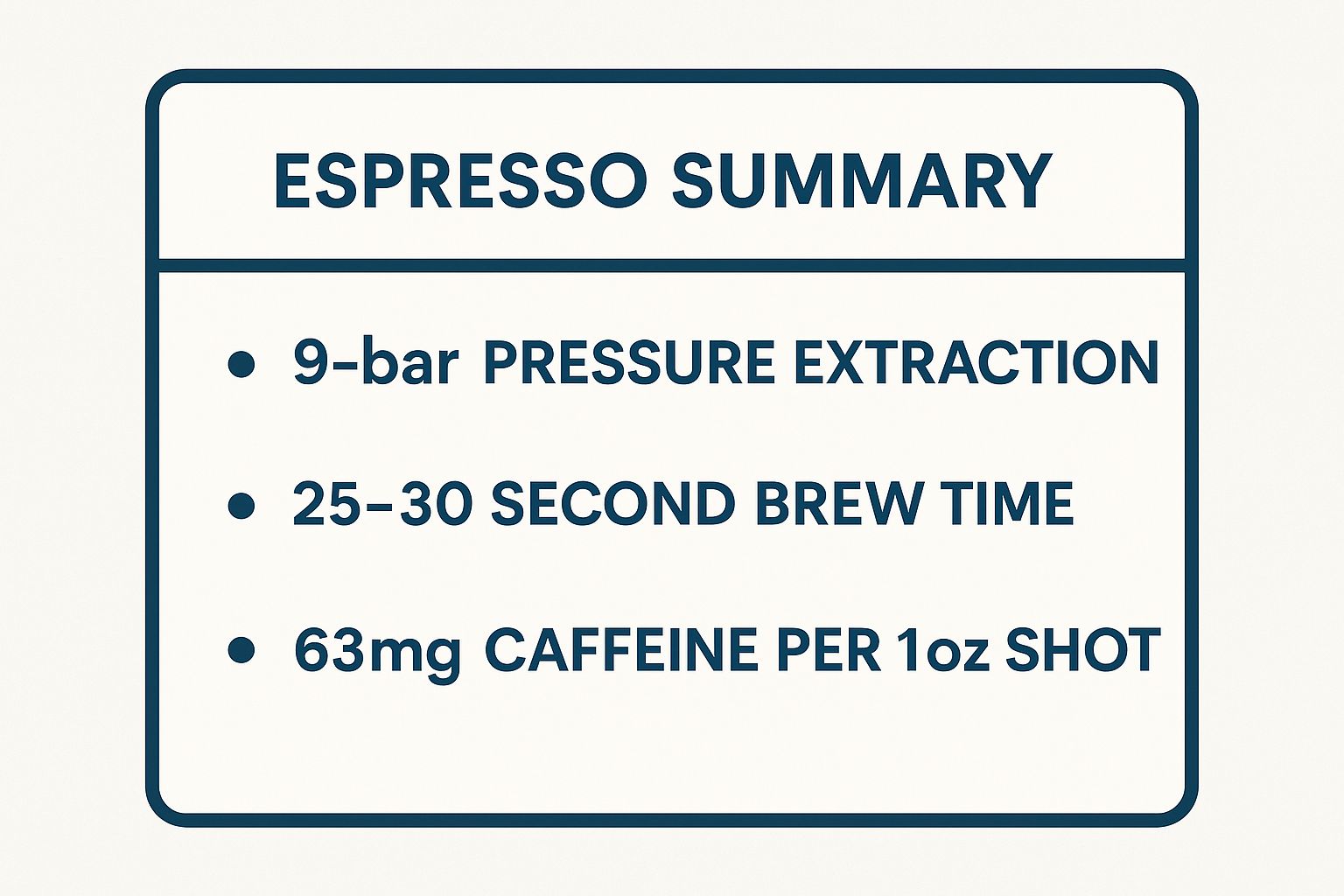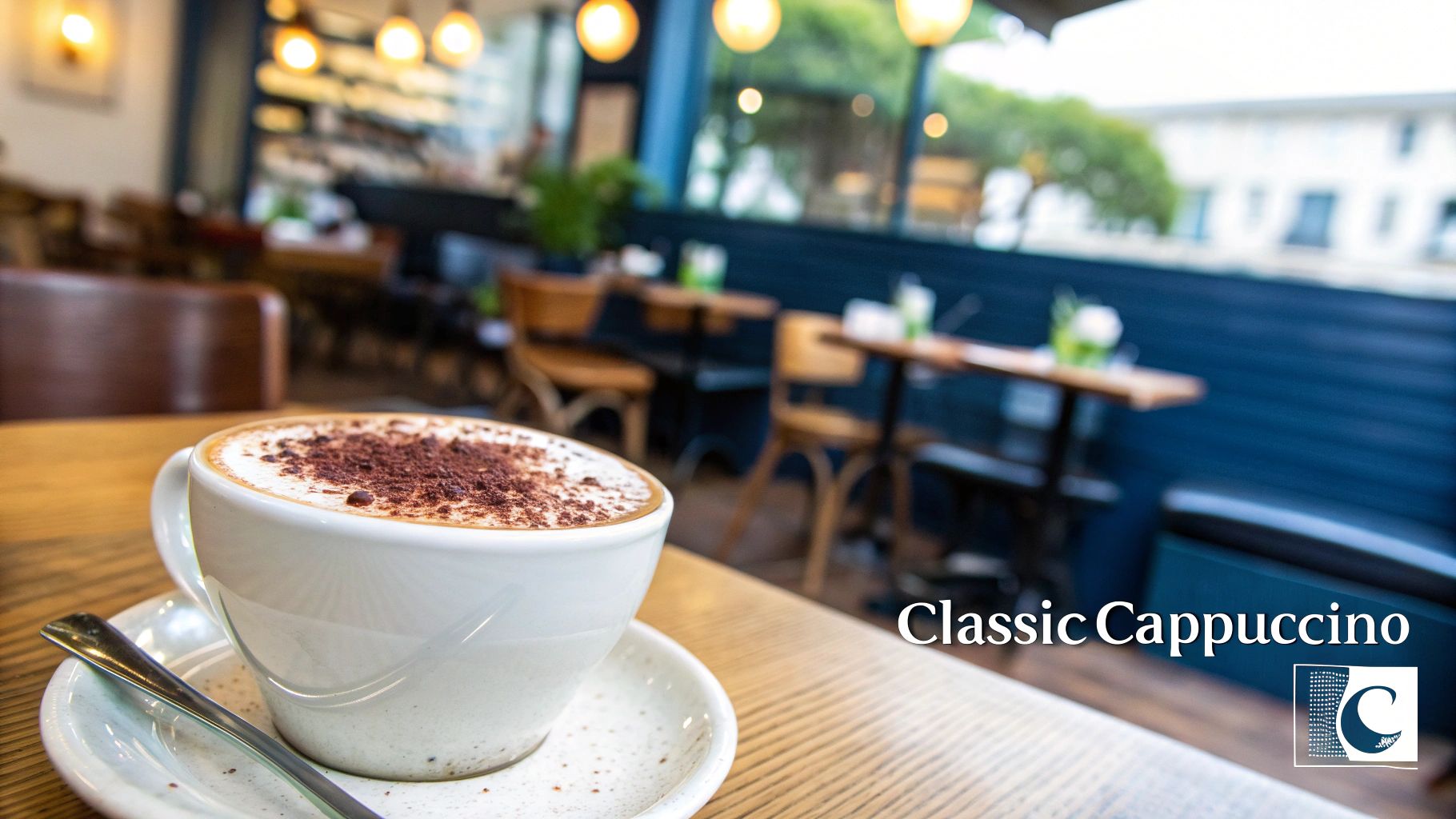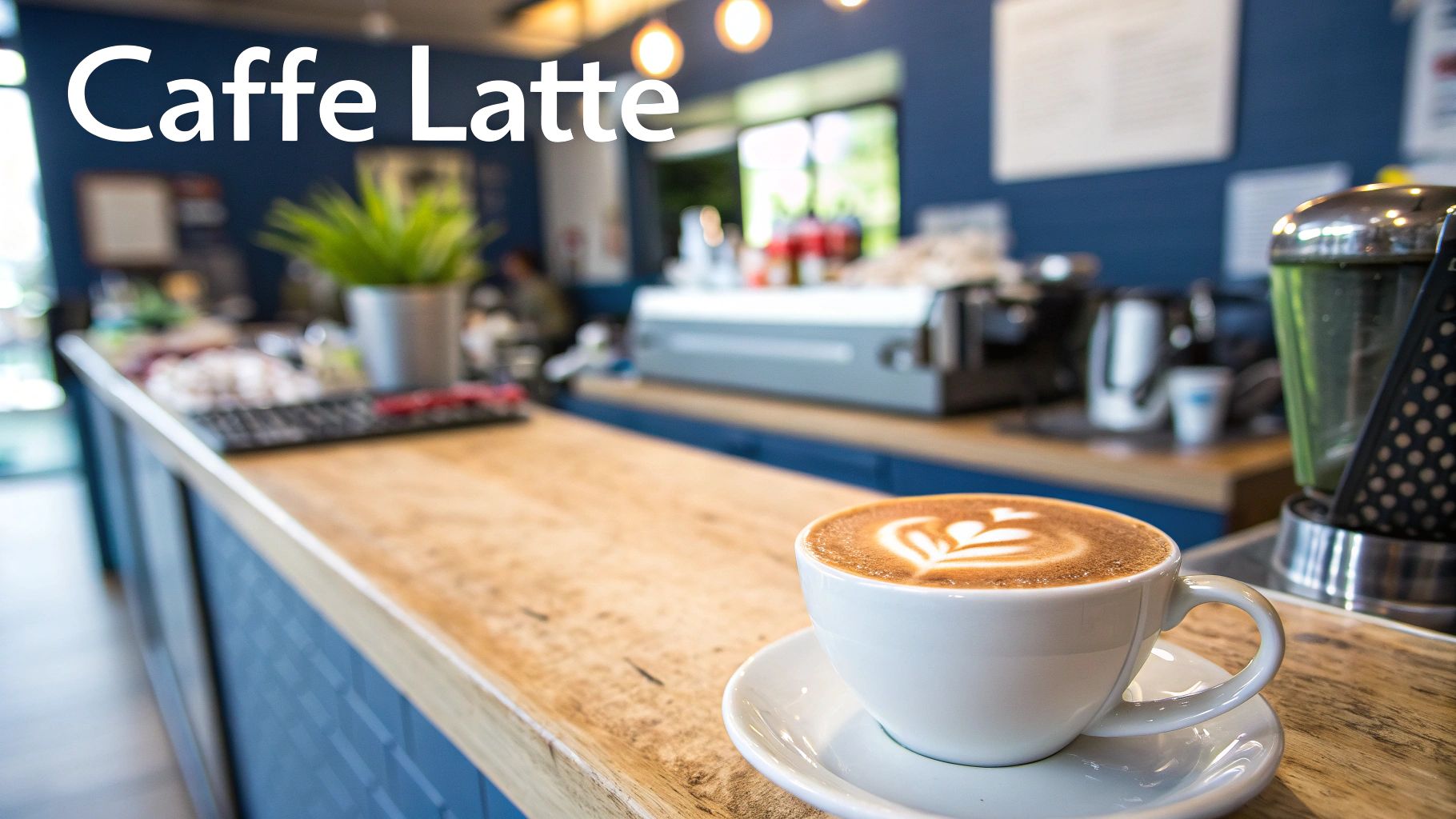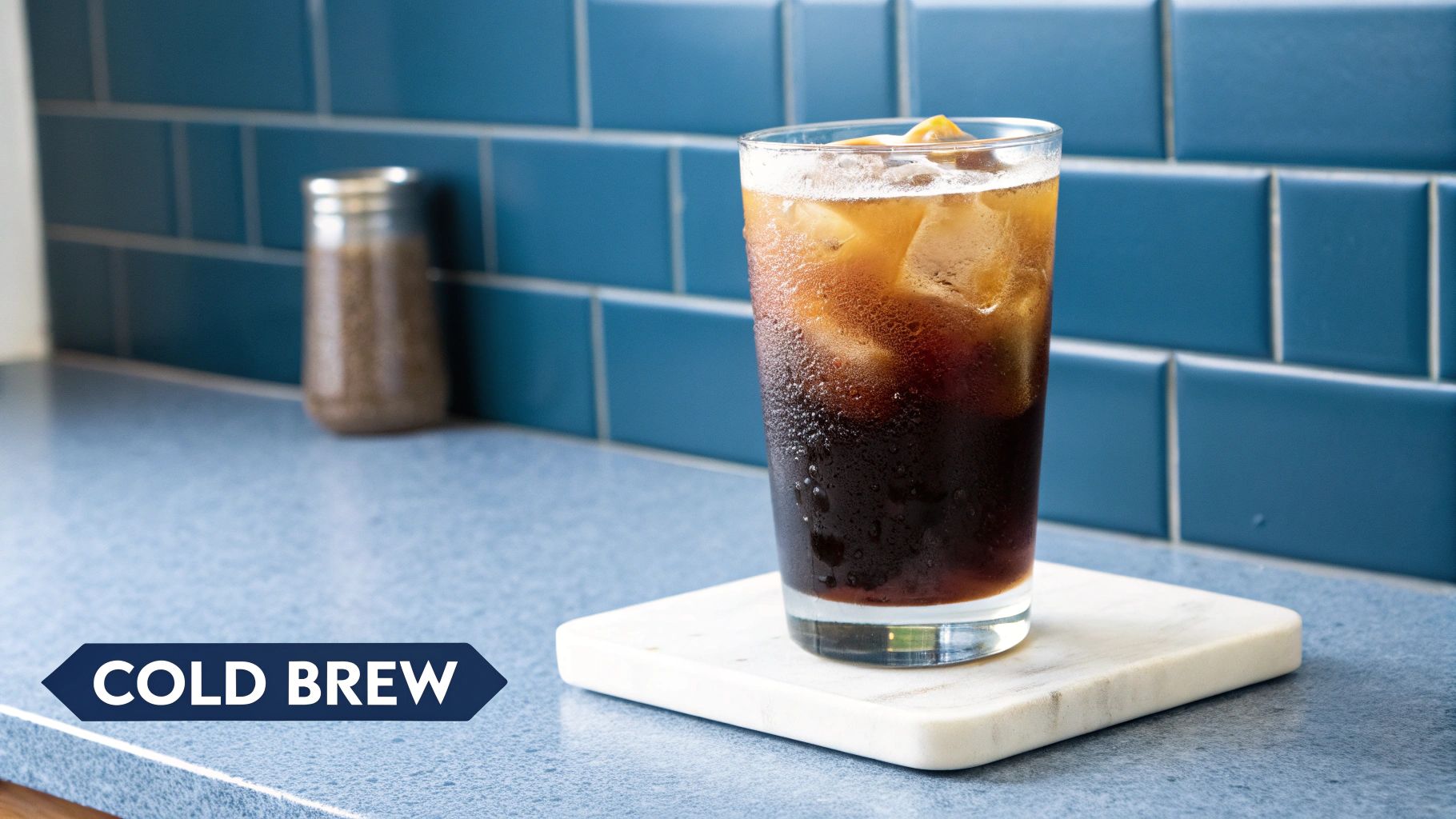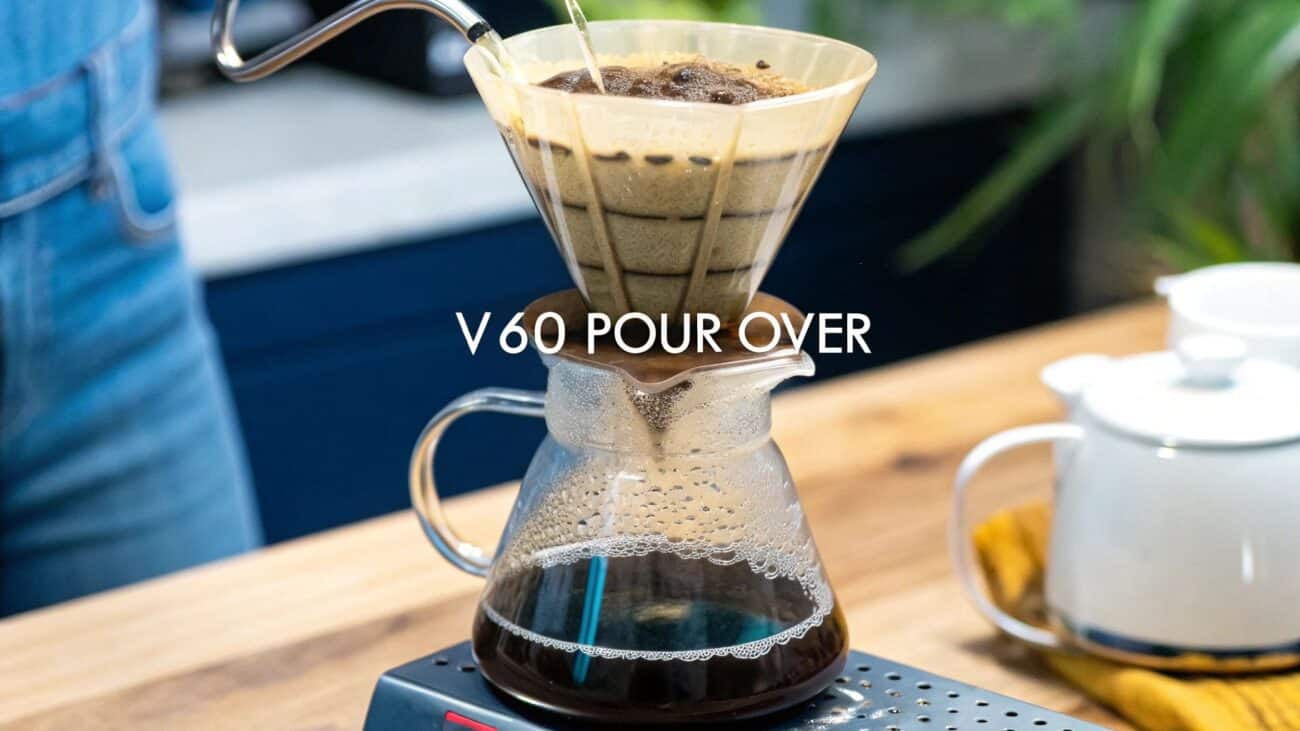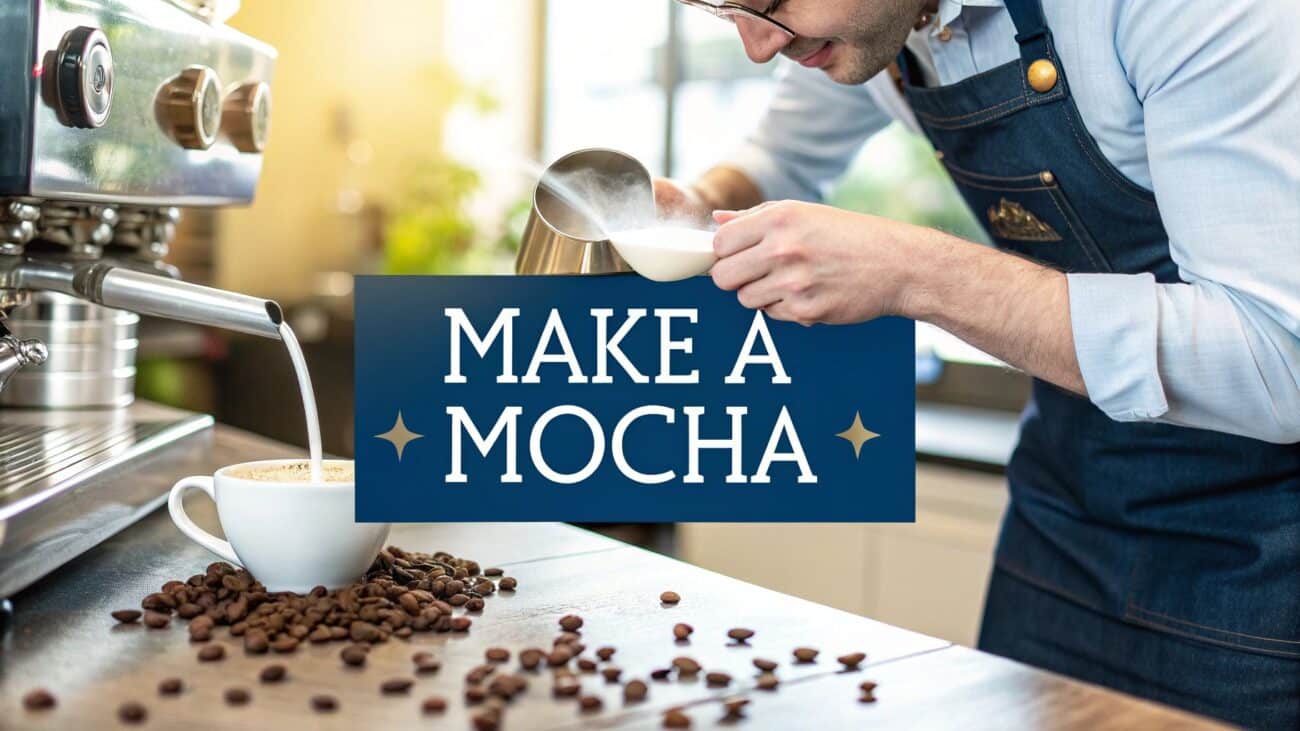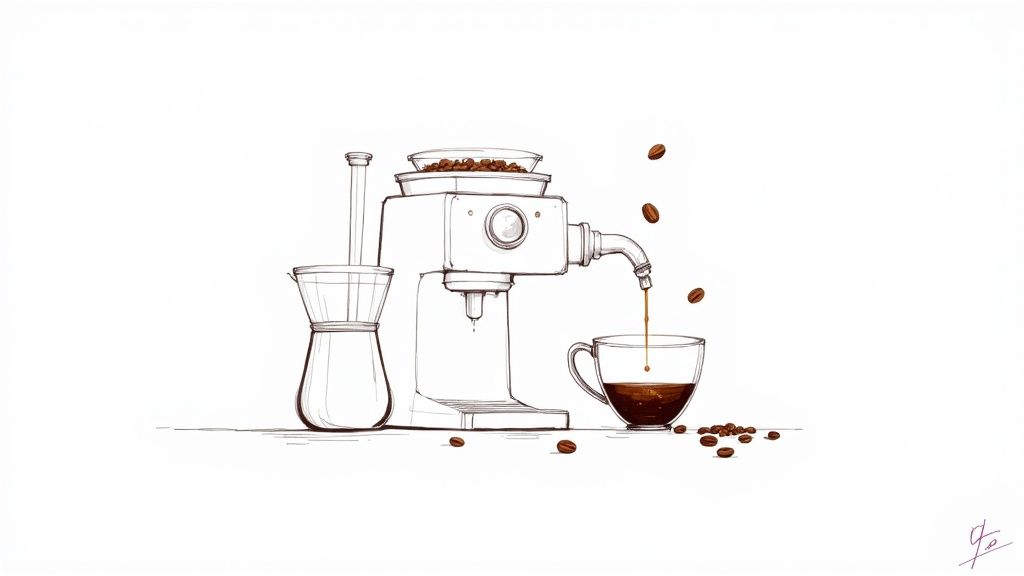10 Common Types of Coffee Drinks Explained (2025 Guide)
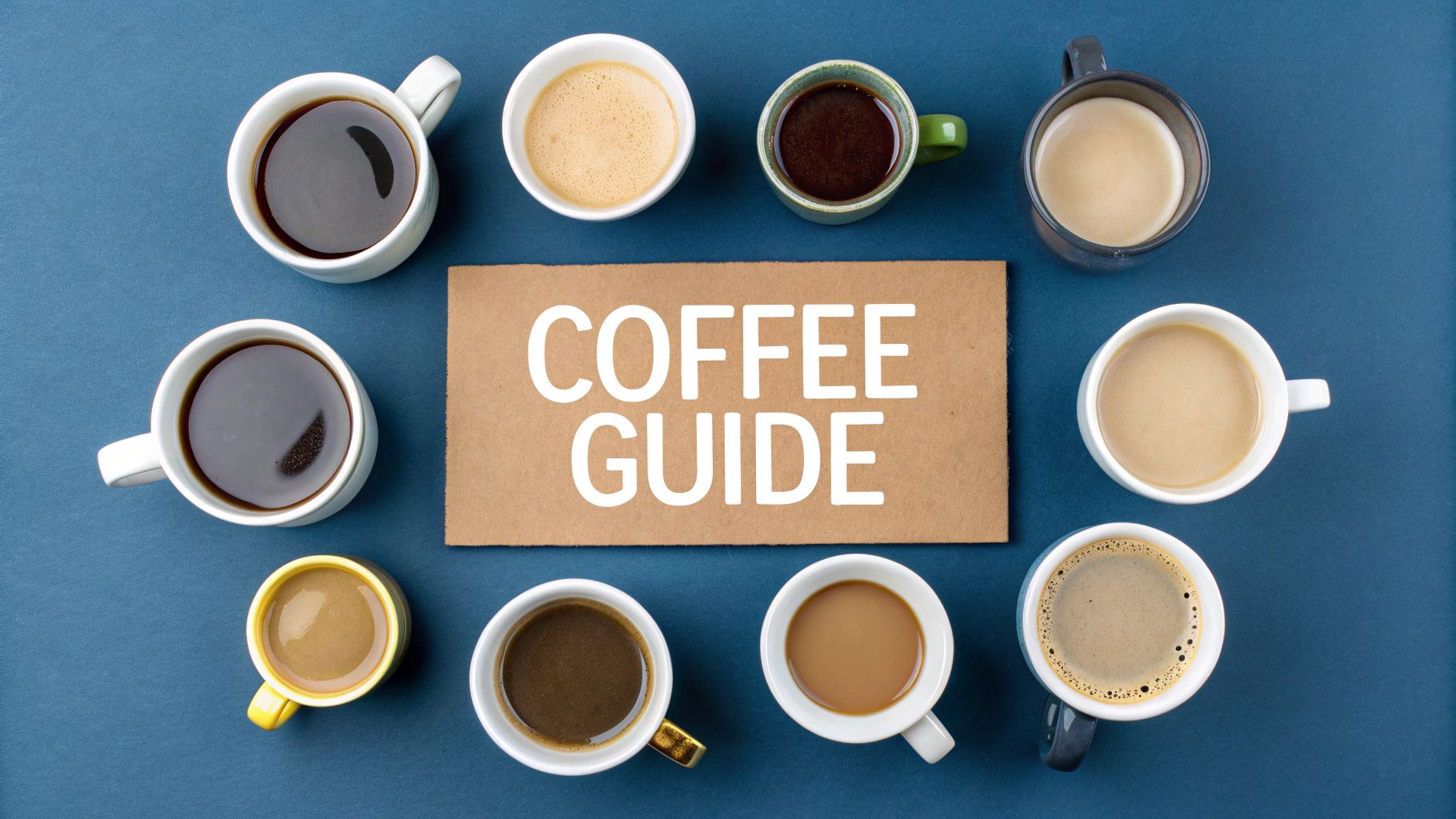
The world of coffee is rich, varied, and often a little confusing. From the intense shot of a pure espresso to the creamy comfort of a latte, understanding the different types of coffee drinks is the first step towards discovering your perfect brew and confidently navigating any café menu. This guide is designed to be your comprehensive resource, demystifying the terminology and techniques behind the world's most beloved coffee creations.
We will explore ten of the most popular and distinct coffee preparations, breaking down each one with practical, actionable detail. You won't just learn the difference between a flat white and a cappuccino; you'll understand the precise espresso-to-milk ratios, the specific milk textures required, and the ideal brewing parameters that define each beverage's unique character and flavour profile. This knowledge empowers you to order with precision and even replicate these drinks in your own kitchen.
For home brewers and aspiring baristas, we’ll provide insights into the specific preparation methods, from pulling the perfect espresso shot to achieving silky microfoam. We'll touch on the core components that form the foundation of most coffee house classics: espresso, steamed milk, and water. By understanding how these simple ingredients are combined in various proportions and textures, you'll gain a deeper appreciation for the artistry involved. Whether you're aiming to refine your home coffee routine or simply expand your palate, this detailed exploration will equip you with the knowledge to make every cup an exceptional one.
1. Espresso
Espresso is the heart of modern coffee culture and a foundational element in any comprehensive list of coffee drink types. Originating in Italy, this brewing method involves forcing a small amount of nearly boiling water, under intense pressure, through finely-ground coffee beans. The result is a highly concentrated, full-bodied coffee shot, typically measuring just 1-2 ounces (around 30-60ml).
This quick extraction process, lasting only 25-30 seconds, captures the most intense and aromatic compounds of the coffee without drawing out excessive bitterness. A perfectly pulled shot is distinguished by its syrupy consistency and a reddish-brown foam on top known as crema. This crema is formed by the emulsification of coffee oils and carbon dioxide, contributing significantly to the espresso's rich flavour and lasting aftertaste.
Why Espresso is a Cornerstone of Coffee
Espresso's unique preparation creates a powerful and complex flavour profile that is impossible to replicate with other methods. It serves as the essential base for a vast array of popular beverages, including lattes, cappuccinos, and Americanos. From traditional Italian espresso bars to third-wave coffee shops highlighting single-origin beans, its versatility is unmatched. The method's precision allows baristas to manipulate variables like grind size, dose, and water temperature to highlight specific tasting notes, from fruity and acidic to chocolatey and nutty.
For a quick reference on the core mechanics of a perfect shot, this summary highlights the key brewing parameters.
These figures demonstrate the precise and intense nature of the extraction, which is crucial for achieving its signature taste and potent caffeine kick.
Tips for Perfecting Your Espresso
Achieving a great espresso at home requires attention to detail. Follow these actionable tips for a café-quality shot:
- Use Fresh Beans: Grind freshly roasted coffee beans (ideally within 2-4 weeks of their roast date) immediately before brewing to preserve volatile aromas.
- Master the "Tamp": Apply firm, even pressure when tamping the coffee grounds to ensure water flows through the puck uniformly, preventing channelling and uneven extraction.
- Dial in Your Shot: Aim for an extraction time between 25-30 seconds. If it’s too fast, your grind is likely too coarse; too slow, and it's too fine. Adjust accordingly.
- Maintain Your Machine: Regularly clean your espresso machine, including the group head and portafilter, to prevent the build-up of old coffee oils that can impart a rancid flavour.
2. Cappuccino
A quintessential Italian classic, the cappuccino is a beautifully balanced and textured coffee drink renowned worldwide. It is meticulously crafted from equal parts espresso, steamed milk, and a thick, luxurious layer of milk foam, traditionally adhering to a 1:1:1 ratio. Served in a 5-6 ounce (around 150-180ml) cup, its defining feature is the harmonious interplay between the bold espresso flavour, the creamy sweetness of the milk, and the airy, velvety foam on top.
The drink’s name is famously linked to the Capuchin friars, as its rich brown colour is said to resemble the hue of their robes. A true cappuccino offers a multi-sensory experience, where each sip delivers a perfect combination of flavour and texture. The foam should be dense enough to hold its shape, creating a distinct mouthfeel that separates it from other milk-based coffee drinks.
Why Cappuccino is a Pillar of Coffee Culture
The cappuccino holds its place as a cornerstone beverage because it perfectly showcases the synergy between espresso and expertly steamed milk. Unlike a latte, which is milk-forward, the cappuccino maintains a robust coffee profile, making it a favourite for those who enjoy the taste of espresso but prefer it softened with creamy texture. Its popularity surged from traditional Italian breakfast pairings to global coffee shop menus, championed by brands like Starbucks and refined by the third-wave coffee movement.
From a simple morning ritual to a canvas for competitive latte art, the cappuccino’s structure allows for subtle yet significant variations. Baristas often offer "dry" versions (more foam) or "wet" versions (more steamed milk), allowing customers to tailor the texture to their preference. For an in-depth guide, explore this resource on how to make a cappuccino.
Tips for Perfecting Your Cappuccino
Creating a café-quality cappuccino at home is an art that requires practice. These actionable tips will help you master the perfect balance of foam, milk, and espresso:
- Use Whole Milk: For the creamiest and most stable foam, whole milk is unparalleled due to its higher fat and protein content.
- Achieve Perfect Temperature: Steam your milk to around 65-70°C (150-155°F). This temperature range caramelises the lactose, enhancing sweetness without scalding the milk.
- Pour with Precision: Begin by pouring the steamed milk into the centre of the espresso shot to combine the liquid parts, then finish by gently spooning the thick foam on top.
- Serve and Enjoy Immediately: The delicate microfoam in a cappuccino degrades quickly. For the best texture and flavour experience, it should be consumed within a few minutes of being made.
3. Latte (Caffè Latte)
The caffè latte is arguably one of the most popular and recognisable espresso-based beverages worldwide, cherished for its smooth, creamy texture and approachable flavour. Originating from the Italian term for "milk coffee," it consists of one or two shots of espresso combined with a generous amount of steamed milk. This mixture is topped with a very thin layer of milk foam, typically just under a centimetre thick, creating a harmonious and velvety drink.
The high milk-to-espresso ratio, often around 6:1, mellows the intensity of the coffee, making it a perfect entry point for those new to espresso drinks. This milky canvas also famously serves as the foundation for latte art, where baristas skilfully pour steamed milk to create intricate designs on the surface. This visual appeal, popularised through social media, has cemented the latte's status as a cultural icon.
Why the Latte is a Global Favourite
The latte’s strength lies in its incredible versatility and balance. It provides a satisfying coffee flavour without the potent punch of a straight espresso, making it an ideal all-day beverage. Its widespread popularisation by chains like Starbucks in the 1980s and 90s introduced espresso-based drinks to a global audience. The subsequent third-wave coffee movement further elevated it, with cafés highlighting how different milks, like oat or almond, can complement single-origin espresso beans.
From a classic Starbucks Vanilla Latte to a sophisticated flat white (a close cousin with less foam from Australia/New Zealand), its adaptability is endless. This drink’s customisable nature allows it to be sweet, unsweetened, dairy-free, or extra strong, catering to nearly every preference among the different types of coffee drinks.
Tips for Perfecting Your Latte
Creating a café-quality latte at home is a rewarding skill. Follow these actionable tips for a superior milky coffee:
- Use the Right Milk: For the best texture and natural sweetness, use whole or semi-skimmed milk. The fat and protein content is crucial for creating silky microfoam that is perfect for pouring art.
- Don't Overheat the Milk: Steam your milk to around 60-65°C. Overheating will scald the milk, destroying its natural sweetness and resulting in a flat, bitter taste.
- Customise the Strength: If you prefer a more robust coffee flavour, especially in larger cups, don't hesitate to request an extra shot of espresso from your barista.
- Experiment with Alternatives: Try alternative milks like oat, almond, or soy. Oat milk, in particular, has gained popularity for its creamy consistency that closely mimics dairy milk.
4. Americano (Caffè Americano)
The Americano, or Caffè Americano, offers a unique bridge between the intensity of espresso and the familiar volume of a filter coffee. This classic drink is made by diluting a shot or two of espresso with hot water, resulting in a larger beverage that retains the distinct, nuanced flavour profile of its espresso base. Its strength is similar to traditional brewed coffee, but its character is entirely different.
The origin story of the Americano is famously traced back to American soldiers stationed in Italy during World War II. Finding the local espresso too strong for their tastes, they would add hot water to mimic the filter coffee they were accustomed to from home. This simple adaptation created a smooth, less intense yet complex coffee experience that has since become a staple in cafés worldwide, making it an essential entry in any list of coffee drink types.
Why the Americano is a Global Favourite
The Americano’s appeal lies in its straightforward elegance and versatility. It allows the drinker to appreciate the complex tasting notes of a specific espresso bean or blend, such as fruity, floral, or chocolatey tones, but in a more mellow and approachable format. Unlike a filter coffee, which has a different extraction method and flavour profile, the Americano preserves the crema and the core aromatic compounds captured during the high-pressure espresso pull.
This drink is perfect for those who enjoy a longer coffee experience without the addition of milk. From the classic version served in Italian coffee bars to the popular Iced Americano, its simplicity makes it a global favourite. A close cousin, the Long Black from Australia and New Zealand, reverses the process by adding espresso to hot water to better preserve the crema. For a comprehensive guide on its preparation, you can explore the steps involved in how to make an Americano coffee drink.
Tips for Perfecting Your Americano
Crafting a great Americano is about balancing the espresso and water to your personal preference. Follow these tips to create a superior cup:
- Preserve the Crema: For a richer mouthfeel and aroma, add the hot water to your freshly pulled espresso shot. Pouring the espresso on top of the water (a Long Black) is even better for crema preservation.
- Control Your Strength: Don't be afraid to specify your preferred water-to-espresso ratio. A standard is often 1:2 (one part espresso to two parts water), but you can adjust this for a weaker or stronger flavour.
- Watch the Water Temperature: Use water that is hot but not boiling (around 85-90°C). Overly hot water can scald the espresso and introduce a bitter taste.
- Use High-Quality Espresso: The Americano has nowhere to hide, so the quality of your espresso is paramount. Use freshly ground, high-quality beans to ensure a delicious and flavourful base.
5. Macchiato (Espresso Macchiato)
The Macchiato is a classic Italian coffee that perfectly balances the intensity of espresso with a whisper of milk. Its name, which means “stained” or “marked” in Italian, accurately describes its composition: a shot of espresso that has been “marked” with a small dollop of steamed milk foam, typically just one or two teaspoons. This minimal addition is not meant to create a milky drink but to gently soften the espresso's bold edges, adding a touch of sweetness and a velvety texture.
Unlike the large, sweet, caramel-laden beverages that share its name in many commercial coffee chains, the traditional Espresso Macchiato is a small, potent, and espresso-forward drink. The purpose of the foam is to lightly temper the initial acidity and bitterness of the espresso shot, allowing its complex flavour profile to shine through without being overpowered. The result is a nuanced beverage that preserves the integrity and character of the coffee beans.
Why the Macchiato is a Purist's Choice
The Espresso Macchiato holds a special place among the various types of coffee drinks because it offers the robust experience of an espresso with just enough modification to make it subtly different. It’s the ideal choice for those who find a straight espresso slightly too intense but feel a cappuccino or latte dilutes the coffee’s character too much. This drink is a testament to the Italian philosophy of using simple, high-quality ingredients to create something exceptional.
From traditional Italian bars where it is served as a quick, stand-up drink to third-wave cafés showcasing single-origin beans, the macchiato is a celebration of espresso itself. Its preparation requires precision, as the small amount of milk must be perfectly foamed to complement, not dominate, the coffee.
Tips for Ordering the Perfect Macchiato
To ensure you get the authentic experience, clarity is key. Follow these actionable tips for a genuine macchiato:
- Be Specific: Always order an "Espresso Macchiato" or a "traditional macchiato" to avoid confusion with the larger, flavoured versions popularised by chains.
- Enjoy It Quickly: A macchiato is best consumed immediately, while the espresso is still hot and the contrast between the liquid and the foam is at its peak.
- Don't Stir: Experience the drink as it was intended. Enjoy the initial cap of foam followed by the rich espresso beneath for a layered flavour journey.
- Know the Alternatives: If you desire a bit more milk but want to stay in the espresso-forward category, a cortado is an excellent alternative with a roughly 1:1 ratio of espresso to steamed milk.
6. Mocha (Caffè Mocha)
The caffè mocha is a popular and indulgent entry in the world of coffee drink types, perfectly blending the richness of espresso with the sweetness of chocolate. This beverage is essentially a latte with an added chocolate element, typically in the form of syrup, sauce, or cocoa powder. It’s a harmonious marriage of robust coffee and decadent dessert, making it a gateway drink for new coffee enthusiasts and a comforting favourite for seasoned drinkers.
The drink's construction involves a shot or two of espresso, a measure of chocolate, and steamed milk, often crowned with whipped cream and a chocolate drizzle. Named after the city of Mocha in Yemen, a historic centre of the coffee trade, the modern mocha offers a balanced flavour profile where the coffee's slight bitterness is beautifully offset by the creamy, sweet notes of chocolate.
Why Mocha is a Go-To Comfort Drink
A mocha’s appeal lies in its ability to satisfy both a caffeine craving and a sweet tooth simultaneously. Unlike more intense, coffee-forward drinks, it provides a gentler introduction to espresso's complexities. This makes it a staple in virtually every coffee shop, from global chains like Starbucks with their famous White Chocolate and Peppermint Mochas to independent cafés using single-origin chocolate for a more artisanal flavour.
Its versatility is a key reason for its enduring popularity. The core recipe can be easily adapted with different types of chocolate, such as dark, milk, or white, and it pairs exceptionally well with various milks and added flavours like caramel or mint, offering a customisable experience for any palate.
Tips for Perfecting Your Mocha
Whether ordering out or making one at home, you can easily tailor a mocha to your preferences. Keep these actionable tips in mind for a superior caffè mocha:
- Choose Your Chocolate Wisely: For a less sweet and more complex flavour, request dark chocolate syrup or use a high-quality, unsweetened cocoa powder when making it at home.
- Control the Sweetness: If you find standard mochas too sugary, simply ask your barista for half the usual amount of chocolate syrup. This lets the coffee flavour shine through more prominently.
- Customise the Topping: Skipping the whipped cream can reduce the calorie count significantly without sacrificing the core flavour of the drink. A light dusting of cocoa powder is a great alternative.
- Experiment with Milks: Alternative milks can transform a mocha. Oat milk adds a creamy, thick texture, while almond milk offers a lighter, nuttier profile that complements the chocolate notes.
7. Cold Brew
Cold brew represents a significant shift in coffee brewing philosophy, favouring patience and time over heat and pressure. This method involves steeping coarsely ground coffee beans in cold or room-temperature water for an extended period, typically between 12 and 24 hours. The mixture is then filtered, leaving behind a smooth, low-acid coffee concentrate that is fundamentally different from traditional hot-brewed coffee that has been cooled down.
This slow, gentle extraction process draws out fewer of the acidic and bitter compounds found in coffee beans, resulting in a naturally sweeter and incredibly smooth flavour profile. The final concentrate is rich and full-bodied, often showcasing deep chocolatey and nutty notes that can be masked by hot brewing methods. Its distinctive taste has made it a favourite in speciality coffee shops and a staple among various types of coffee drinks.
Why Cold Brew is a Modern Staple
The appeal of cold brew lies in its unique flavour and remarkable versatility. Because it is less acidic, it is often preferred by coffee drinkers with sensitive stomachs. Its concentrated nature means it can be diluted with water, milk, or a non-dairy alternative to create a perfectly customised drink without losing its potent coffee character. For those who prefer to keep their Cold Brew perfectly chilled or other coffee types hot during travel, using appropriate insulated hot and cold tumblers can be highly beneficial.
From the bottled versions popularised by Stumptown Coffee Roasters to Starbucks' mainstream adoption and the rise of Nitro cold brew on tap, this brewing style has proven its staying power. To explore which beans work best for this method, you can learn more about the best coffee for cold brew.
Tips for Perfecting Your Cold Brew
Making great cold brew at home is simple with the right technique. Follow these actionable tips for a delicious batch:
- Go Coarse: Use a coarse grind similar to breadcrumbs. A fine grind will result in over-extraction and a cloudy, silty coffee.
- Mind Your Ratios: Start with a coffee-to-water ratio of 1:5 for a strong concentrate that you can dilute later. Adjust based on your taste preference.
- Be Patient: Allow the coffee to steep for at least 12 hours at room temperature or up to 24 hours in the refrigerator. Rushing this step will lead to a weak, underdeveloped flavour.
- Store it Properly: Keep your finished concentrate in a sealed container in the fridge. It will stay fresh and delicious for up to two weeks, providing you with instant coffee all week long.
8. Flat White
A staple in Antipodean café culture, the Flat White is a sophisticated espresso-based drink that has gained immense global popularity. Originating in Australia and New Zealand in the 1980s, it consists of a double shot of espresso topped with steamed milk and finished with a very thin, velvety layer of microfoam. This drink is defined by its smaller size, typically 5-6 ounces, which creates a higher coffee-to-milk ratio compared to a latte.
The key to a true Flat White is the texture of the milk. The microfoam is created by steaming milk to a silky, glossy consistency without creating the thick, airy froth found on a cappuccino. This allows the milk to integrate fully with the espresso, resulting in a smooth, strong coffee-forward beverage where the flavour of the espresso is prominent, yet perfectly balanced by the sweetness of the milk.
Why the Flat White Stands Out
The Flat White holds its place in any list of coffee drink types because it offers a perfect middle ground between the intensity of a pure espresso and the milkiness of a latte. Its velvety texture and strong coffee flavour appeal to those who want to taste the nuances of the espresso beans without them being diluted. This drink is a showcase of a barista's skill, as achieving the perfect microfoam requires precision and practice.
From its origins in Sydney and Auckland cafés to its introduction at Starbucks and its place on third-wave coffee shop menus, the Flat White has become a go-to for discerning coffee drinkers. For those interested in replicating this café favourite, understanding the specific technique is crucial. You can learn more about how to make a Flat White and master the art of microfoam.
Tips for Ordering and Enjoying a Flat White
To ensure you get an authentic experience, keep these actionable tips in mind:
- Seek Out Speciality Cafés: Order from independent or third-wave coffee shops where baristas are trained in traditional microfoam techniques for the most authentic version.
- Know What to Expect: A Flat White should have a strong but smooth coffee taste. Don't expect the thick, stiff foam characteristic of a cappuccino or the larger, milkier volume of a latte.
- Specify Your Preference: If you are particular, you can ask for a "traditional" Flat White to ensure you receive the smaller 5-6 ounce serving size with a thin layer of microfoam.
- Appreciate the Texture: Pay attention to the silky mouthfeel. The velvety consistency is the hallmark of a well-made Flat White and what sets it apart from other types of coffee drinks.
9. French Press (Press Pot/Cafetière)
The French press, also known as a cafetière or press pot, is a beloved manual brewing method celebrated for its simplicity and ability to produce a full-bodied, richly flavoured coffee. This immersion technique involves steeping coarsely ground coffee in hot water within a cylindrical carafe. After a few minutes, a plunger with a fine mesh filter is pressed down, separating the grounds from the liquid and leaving a robust and aromatic brew.
This direct-contact brewing process allows the coffee's natural oils and fine particles to remain in the final cup, which is impossible with paper-filtered methods. The result is a coffee with a heavier mouthfeel, a velvety texture, and a complex flavour profile that truly showcases the bean's inherent characteristics. From classic glass Bodum designs to durable stainless steel models, its timeless appeal makes it a staple in homes and cafés.
Why the French Press is a Manual Brewing Favourite
The French press stands out as one of the most accessible yet rewarding types of coffee drinks for those who appreciate a full-bodied cup. Its immersion style offers a more forgiving brewing process compared to methods like pour-over, while still giving the user significant control over the final taste. This method is perfect for highlighting the deep, chocolatey, and nutty notes often found in medium to dark roast coffees.
Its simplicity and lack of disposable filters also make it a sustainable and cost-effective choice for daily brewing. Whether used for a quiet morning ritual or for serving guests, the cafetière consistently delivers a satisfying and flavourful experience. For those looking to explore this method further, choosing the right beans is crucial. You can learn more about the best coffee for a French press to elevate your brew.
Tips for Perfecting Your French Press
Achieving a great brew with a cafetière is straightforward with attention to a few key details. Follow these actionable tips for a delicious, sediment-free cup:
- Use a Coarse Grind: A consistent, coarse grind is essential to prevent silt from passing through the mesh filter and to avoid over-extraction, which causes bitterness.
- Get the Ratio Right: A great starting point is a 1:15 coffee-to-water ratio. For a standard 8-cup press, use about 55-60 grams of coffee to 1 litre of water.
- Bloom the Grounds: After adding your coffee, pour just enough hot water (around 93-96°C) to saturate the grounds and let them "bloom" for 30 seconds. This releases trapped CO2 and enhances flavour.
- Steep for Four Minutes: The ideal steeping time is exactly four minutes. Any longer risks bitterness, while any less can result in a weak, under-extracted brew.
- Press Slowly and Pour Immediately: Press the plunger down with slow, steady pressure. Once pressed, decant all the coffee immediately into cups or a separate carafe to halt the extraction process and prevent the coffee from becoming bitter.
10. Turkish Coffee
Turkish Coffee is one of the oldest and most culturally significant types of coffee drinks, representing a method rather than a specific bean. Originating in the Ottoman Empire, this technique involves brewing unfiltered, powder-fine ground coffee in a special pot called a cezve or ibrik. The coffee is gently heated with water and often sugar, creating an intensely strong and thick beverage with a characteristic foam on top.
This time-honoured brewing process, recognised by UNESCO as an Intangible Cultural Heritage of Humanity, results in a unique and powerful flavour experience. The final brew is poured directly into small cups, allowing the fine grounds to settle at the bottom. This method captures the full essence of the coffee, delivering a rich, full-bodied taste that is both robust and aromatic.
Why Turkish Coffee is a Cornerstone of Coffee
Turkish Coffee offers a direct link to the historical roots of coffee consumption and showcases a brewing style that prioritises texture and intensity. Its preparation is a ritual, deeply embedded in social traditions across the Middle East, North Africa, and the Balkans. This method stands out because it doesn't filter the grounds, which contributes to its unique syrupy mouthfeel and long-lasting flavour.
From traditional coffee houses in Istanbul to speciality cafés exploring ancient techniques, Turkish Coffee provides an authentic and deeply satisfying experience. The ability to customise sweetness during the brewing process (from unsweetened, sade, to very sweet, şekerli) makes it a versatile and personal drink.
Tips for Perfecting Your Turkish Coffee
Brewing authentic Turkish Coffee is an art that requires patience and attention. Follow these tips for a perfect cup:
- Use a Powder-Fine Grind: Your coffee must be ground to the consistency of flour. Most pre-ground coffees are too coarse, so seek out a speciality Turkish grind.
- Start with Cold Water: Always use cold, filtered water to begin the brewing process. This allows for a slow temperature increase, which is essential for developing a thick foam.
- Brew Slowly: Gently heat the cezve over low heat. Rushing the process will ruin the foam and result in a bitter taste. Never let it come to a rolling boil.
- Distribute the Foam: Before pouring the coffee, use a small spoon to distribute some of the foam into each cup. This ensures everyone gets a share of the best part.
- Let It Settle: After pouring, wait a minute or two for the grounds to settle at the bottom of the cup before you begin sipping.
Top 10 Coffee Drinks Comparison
| Coffee Type | Implementation Complexity 🔄 | Resource Requirements ⚡ | Expected Outcomes 📊 | Ideal Use Cases 💡 | Key Advantages ⭐ |
|---|---|---|---|---|---|
| Espresso | High – requires expensive machine and skill | High – espresso machine, fine grind, fresh beans | Intense, concentrated shot with crema and rapid extraction | Base for speciality drinks, quick caffeine boost | Rich flavour, quick prep, versatile base |
| Cappuccino | Moderate – skill needed for microfoam | Moderate – espresso machine, steamed milk | Balanced coffee-milk flavour, creamy texture and foam | Morning beverage, balanced milk-coffee drink | Smooth, visually appealing, moderately quick |
| Latte (Caffè Latte) | Moderate – milk steaming & espresso shots | Moderate to high – espresso machine, more milk | Mild, creamy coffee with thin foam, large volume | Coffee beginners, customisable flavours, latte art | Smooth, larger size, customisable |
| Americano | Low – simple espresso + hot water | Low – espresso machine + hot water | Espresso flavour diluted; smooth, less intense coffee | Low-calorie option, similar strength to drip coffee, quick prep | Larger serving, retains espresso notes |
| Macchiato | Low to moderate – espresso with small milk foam | Low – espresso machine, small milk foam | Strong espresso with slight milk softness | Espresso lovers wanting a slight milk touch | Intense flavour, quick, low calorie |
| Mocha (Caffè Mocha) | Moderate – espresso + chocolate + steamed milk | Moderate – espresso machine, chocolate syrup or powder | Sweet, dessert-like coffee with chocolate flavour | Sweet tooth, coffee beginners, dessert drink | Sweet, customisable, appealing to non-coffee drinkers |
| Cold Brew | High – long steeping (12-24 hrs), filtering | Low – coarse grind, cold water, brewing container | Smooth, less acidic, naturally sweet cold coffee | Refreshing cold coffee, low acid preference, make-ahead | Low acidity, smooth, easy at-home method |
| Flat White | Moderate – skilled milk steaming, double ristretto | Moderate – espresso machine, steamed milk | Stronger coffee-milk balance, velvety texture, smaller cup | Coffee enthusiasts wanting strong but creamy drink | Strong flavour, smooth mouthfeel, balanced size |
| French Press | Low – manual immersion brewing with plunger | Low – French press, coarse grind, hot water | Full-bodied, robust coffee with oils and sediment | Portable/manual brewing, multiple servings, rich flavour | Inexpensive, no electricity, full control |
| Turkish Coffee | High – precise fine grind, boiling method | Low – cezve pot, very fine grounds | Thick, intense coffee with grounds and foam, culturally significant | Traditional/cultural ritual, strong coffee experience | Rich cultural heritage, intense flavour |
Finding Your Perfect Coffee Match
Our journey through the diverse world of coffee has taken us from the intense, concentrated shot of an Espresso to the rich, velvety texture of a Flat White, and even to the ancient ritual of brewing Turkish Coffee. We have explored ten distinct types of coffee drinks, each offering a unique sensory experience defined by its brewing method, milk-to-coffee ratio, and cultural heritage. The key takeaway is that the universe of coffee is far richer and more varied than a simple choice between black or white.
The true beauty of coffee lies in its versatility. The same high-quality coffee bean can yield a bold, syrupy Espresso, a smooth and elongated Americano, or a creamy, comforting Latte. Understanding the fundamental differences, such as the microfoam in a Cappuccino versus the steamed milk in a Latte, or the slow extraction of Cold Brew versus the rapid pressure of an espresso machine, empowers you to make more informed choices, both at your local café and in your own kitchen.
Your Path to Coffee Mastery
So, where do you go from here? The path to discovering your perfect coffee is one of delicious experimentation. Rather than sticking to your usual order, consider this guide your personal coffee menu, an invitation to step outside your comfort zone.
Here are some actionable next steps to continue your exploration:
- The Milk Ratio Challenge: If you typically enjoy a milky Latte, try a Flat White for a more coffee-forward flavour with a similar creamy texture. If you prefer less milk, a Macchiato offers the perfect middle ground between a potent Espresso and a full-sized Cappuccino.
- Temperature Exploration: On a warm day, swap your usual hot Americano for a smooth, low-acidity Cold Brew. The difference in extraction method creates a completely different flavour profile, often sweeter and less bitter.
- Embrace the Ritual: Go beyond automated machines. Invest in a French Press (or Cafetière) and experience the full-bodied, rich flavour that immersion brewing provides. It’s a simple, hands-on method that connects you more deeply to the brewing process.
The most crucial element in this entire equation is the quality of your beans. A flawlessly prepared Cappuccino made with stale, poor-quality beans will always fall short of a simple French Press brew made with freshly roasted, ethically sourced coffee. The origin, roast profile, and freshness of your coffee are the foundations upon which every great drink is built.
The Art of Personal Preference
Ultimately, navigating the vast landscape of types of coffee drinks is a deeply personal adventure. There is no right or wrong answer; the "best" coffee drink is the one that brings you the most enjoyment. It’s about understanding the components, from grind size to water temperature, so you can tailor the experience to your exact preferences. Whether it’s the invigorating jolt of a morning espresso or the comforting warmth of an evening mocha, the goal is the same: a satisfying and flavourful cup. It’s about appreciating not just the final product, but also the craft behind it and the act of sipping coffee that brings a moment of pause and pleasure to your day.
By experimenting with these different preparations, you are not just finding a beverage; you are cultivating a skill and a deeper appreciation for one of the world’s most beloved drinks. Happy brewing!
Ready to start your brewing adventure with exceptional, ethically sourced beans? Explore the curated selection at Seven Sisters Coffee Co to find the perfect foundation for any of the coffee drinks we’ve covered. From single-origin espressos to versatile blends ideal for your French Press, their commitment to quality will elevate your home coffee experience.

